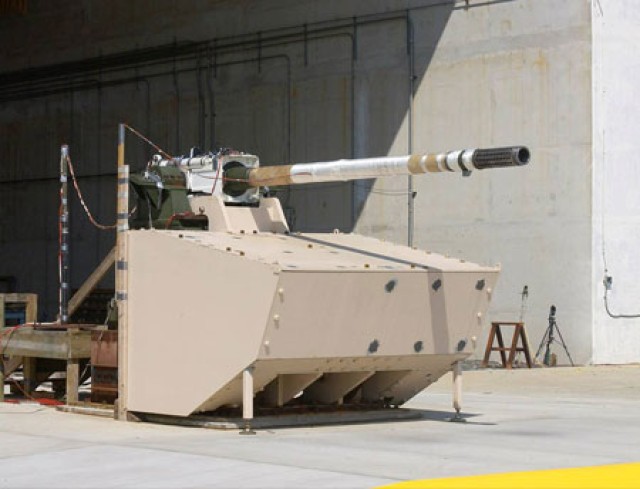
ABERDEEN, Md. (Army News Service, Jan. 26, 2009) Aca,!" The lightweight Future Combat Systems XM-360 120mm cannon -- designed to sit atop the new Mounted Combat System -- was test-fired here Jan. 22.
The XM-1202 Mounted Combat System is one of eight new vehicle types that the Army is developing through its FCS modernization program. The FCS vehicles will be lighter and more mobile than current Army combat vehicles; yet officials promise they will have greater lethality and survivability.
Lighter and more survivable vehicles are required to combat a growing array of new and more sophisticated threats, officials here said. Greater speed and mobility, coupled with better surveillance and reconnaissance capabilities, can enhance operational effectiveness, while improving survivability, they said.
Composite FCS armor, for instance, which is being developed at Aberdeen, provides better armor protection at significantly less mass and weight.
Aca,!A"This will change the nature of warfare,Aca,!A? said Rick Crozby, an official with the Combined Test Organization for the FCS Brigade Combat Team at Aberdeen. Aca,!A"With these new [FCS] technologies, our Soldiers will have the ability to checkmate their enemies before their enemies even know that theyAca,!a,,cre there.Aca,!A?
FCS is being developed at dozens of test and development sites nationwide, and some of the significant work is being done at Aberdeen.
Maj. Cliff Calhoun, assistant product manager for the Mounted Combat System, said the test-firing is one of several that would occur over a few days that would bring the total number of firing trials for the cannon to 1,000. The weapon, he said, is significant because it is as powerful as the one mounted on the M1-A2 Abrams tank -- also a 120mm gun -- but comes in with significant savings in weight and provides automation that will help prevent the loss of lives.
"The Mounted Combat System is going to feature an automatic ammunition handling system," Calhoun explained. "Our current force Abrams has a crew of four men -- a gunner, tank commander, driver and loader. On the MCS, there's a crew of three men -- an automated loader takes care of that loading function. So instead of having four Soldiers in harm's way, only three Soldiers are in harm's way with the MCS."
The MCS carries up to 27 shells that are for a mechanized loader to pull into the cannon. The automated system means that Soldiers do not need to hand-load the heavy shells.
Coupled with other FCS technology, the MCS will also bring beyond-line-of-sight capability to the battlefield, Calhoun said.
"In the current force, a tank can engage everything it can see out to about three kilometers -- if you can see it you can engage it," he said. "With the MCS, you are going to be able to -- through the network -- engage targets beyond line-of-sight."
The FCS constellation of equipment includes two unmanned aerial vehicles -- the XM-156 Class I UAV and the XM- 57 Class IV UAV. Either of those could be beyond the line-of-sight of the MCS, spotting potential threats, and then feed targeting information into the FCS network for use by MCS commanders.
"If we have an enemy vehicle on the far side of a terrain feature, for example, the network will be able to send imagery back to the MCS and we can engage and destroy in distances exceeding 10 kilometers," Calhoun said.
The armament on the MCS mission module is also going to be lighter, as a result of carbon-fiber composites and an aluminum frame construction, said Edward Hyland, of BenAfAt Labs.
"Our main goal was that we wanted all the performance of a current gun, but in a lightweight compact package," Hyland said. "To do that we looked at the entire design of the gun, at every part, and asked how can we make it lighter and push it to the edge."
Hyland said the Army, in cooperation with defense contractor General Dynamics, looked at new high-strength gun steels, lightweight alloys, titanium, aluminum, and carbon-fiber composites.
"The barrel on the Abrams tank is over 2500 pounds," Hyland said. "Using these high- strength steels and carbon-fiber composites, we've taken off over 800 pounds from that. (The MCS gun) weighs a little over 1,700 pounds -- 800 pounds lighter than the Abrams. That's just the gun barrel. We did the same thing with the breech assembly and the recoil assembly. Overall the net weight savings is well over 2,000 pounds, actually 2,400 to 2,500 pounds lighter than the current gun -- yet it has all the capabilities of that gun."
Hyland said a gun as powerful as the 120mm cannon needed to be modified to reduce recoil, so it would be compatible with the lightweight MCS vehicle.
"What we had to do was drop the recoil forces so we could fire from a lightweight platform," Hyland said. "We did that in two ways. We added a muzzle break to the gun tube and also optimized recoil system -- like a shock absorber on a car. We've optimized it for this lightweight platform."
Hyland said that modifications to the cannon did not make it any less effective or accurate, and that in the last three or four years of testing, they have demonstrated the gun has met accuracy, recoil and weight requirements for FCS.
The recent series of test-firings of the XM-360 120mm cannon will bring the system to technology readiness level 6, which means the system has been demonstrated in a "relevant environment" and represents a "major step up in a technology's demonstrated readiness."

Social Sharing